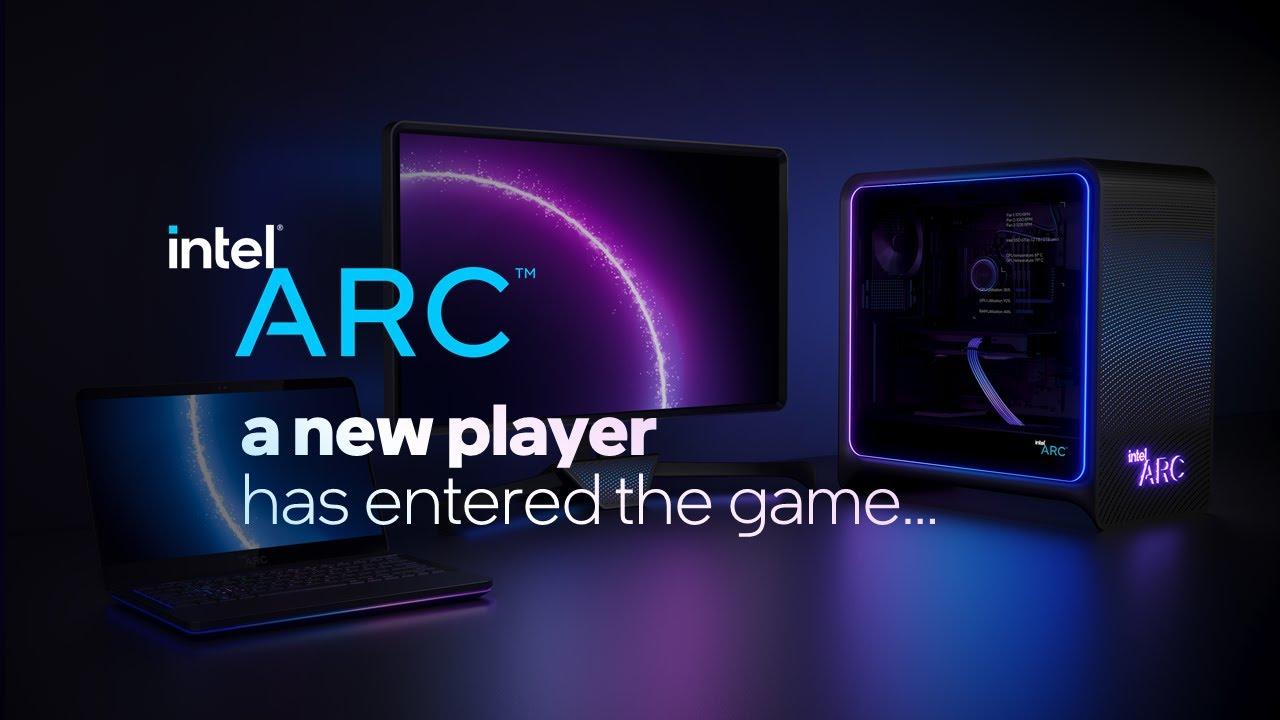Intel Arc Graphics is finally here, as Intel officially enters the discrete GPU game and here's the details.
The first set is the Intel Arc A-series for laptops, with Arc 5 and Arc 7 coming in "early summer". Desktop / Workstation dedicated GPUs will be available sometime "later this year" with no clearer date yet being given. So unlike NVIDIA and AMD, they're not jumping in at the deep end first, doing a trickle roll-out starting at the lower end. This is an interesting step, which will enable them to really get their drivers in good shape before the possible masses flock towards their higher-end offerings later in the year.
Click shots to enlarge:
Specs sheets:
| Model Number | A350M | A370M | A550M | A730M | A770M |
| Microarchitecture | Xe HPG | Xe HPG | Xe HPG | Xe HPG | Xe HPG |
|
Lithography Type
|
TSMC N6 | TSMC N6 | TSMC N6 | TSMC N6 | TSMC N6 |
| Status | Launched | Launched | Announced | Announced | Announced |
| Xe-cores | 6 | 8 | 16 | 24 | 32 |
| Render Slices | 2 | 2 | 4 | 6 | 8 |
| Ray Tracing Units | 6 | 8 | 16 | 24 | 32 |
| Intel® Xe Matrix Extensions (Intel® XMX) Engines | 96 | 128 | 256 | 384 | 512 |
|
Xe Vector Engines
|
96 | 128 | 256 | 384 | 512 |
|
Graphics Base Clock
|
1150 MHz | 1550 MHz | 900 MHz | 1100 MHz | 1650 MHz |
|
TGP
|
25-35W | 35-50W | 60W-80W | 80W-120W | 120W-150W |
|
PCI Express Configurations
|
Up to PCI Express 4.0 x8 | Up to PCI Express 4.0 x8 | Up to PCI Express 4.0 x16 | Up to PCI Express 4.0 x16 | Up to PCI Express 4.0 x16 |
|
Device ID
|
0x5694 | 0x5693 | 0x5692 | 0x5691 | 0x5690 |
|
Memory Size
|
4 GB | 4 GB | 8 GB | 12 GB | 16 GB |
|
Memory Type
|
GDDR6 | GDDR6 | GDDR6 | GDDR6 | GDDR6 |
|
Graphics Memory Interface
|
64 bit | 64 bit | 128 bit | 192 bit | 256 bit |
|
Graphics Memory Bandwidth
|
112 GB/s | 112 GB/s | 224 GB/s | 336 GB/s | 512 GB/s |
|
Graphics Memory Speed
|
14 Gbps | 14 Gbps | 14 Gbps | 14 Gbps | 16 Gbps |
You can see their full stream below:

Direct Link
Some of the features supported:
- Intel Xe Matrix Extensions (XMX) AI engines provide more compute capability for accelerating AI workloads. These AI engines have 16 times the compute to complete AI inferencing operations when compared to traditional GPU vector units, which can increase performance in productivity, gaming and creator applications.
- Xe Super Sampling (XeSS) is our solution that leverages the power of Intel Arc graphics’ XMX AI-engines to deliver high-performance, AI-accelerated upscaling. XeSS is a novel upscaling technology that uses deep learning to synthesize images that are very close to the quality of native high-res rendering. XeSS is coming in the summer and will be supported on all products with Arc A-Series graphics.
- Intel Arc A-Series GPUs are the first in the industry to offer full AV1 hardware acceleration, including both encode and decode, delivering faster video encode and higher quality streaming while consuming the same internet bandwidth. We’ve worked with industry partners to ensure that AV1 support is available today in many of the most popular media applications, with broader adoption expected this year. The AV1 codec will be a game changer for the future of video encoding and streaming.
- We’ve integrated Intel® Deep Link technologies to enable Intel Arc GPUs to work seamlessly with Intel CPUs and integrated graphics for a performance improvement across gaming, creating and streaming workloads. Intel Deep Link enables dynamic power sharing, intelligently distributing power across the platform to increase application performance up to 30% in creation and compute-intensive applications.1 With Hyper Encode and Hyper Compute, Deep Link allows multi-engine acceleration in transcoding and AI tasks. More details are available in our product fact sheet.
At the end of the announcement, they also teased their first discrete desktop GPU in a limited edition:
"Today marks the first step in our journey. You’ll see Intel Arc graphics continue to improve and evolve, with new features and an ever-expanding ecosystem coming throughout the year. And for desktop enthusiasts, our Intel Arc graphics add-in-cards will be coming this summer. We are excited, and we hope you are too. It’s going to be a big year for Intel Arc graphics." — Roger Chandler is vice president and general manager of Graphics and Gaming Team at Intel Corporation.
Honestly, I'm excited. A third vendor properly jumping into it to mix things up, we've been stuck with just AMD or NVIDIA for far too long. Plus another vendor with open source drivers on Linux too, that's great. Some of the big main features will be supported on Linux too of course like Ray Tracing. As expected, all their testing and presentations are focused on Windows. When it comes to their new Arc Control software though, I doubt that will be supported on Linux, just like the other vendors don't give us their fancy control panels.
See more on the Intel press release.
Last edited by Purple Library Guy on 30 Mar 2022 at 4:22 pm UTC
When it comes to their new Arc Control software though, I doubt that will be supported on Linux, just like the other vendors don't give us their fancy control panels.
Only thing these provide of any value are the game profiles. The way native Linux gaming is going, I doubt it would be worth the effort anyways.
Though, if there are more Native Linux games in the future and larger user base I would like to see that feature brought over to Linux.

**av1 decode and encode support in lower mobile gpus, meanwhile crappy mobile gpus ported to desktop like rx 6500 xt launched in 2022 dont have decode and encode support
selling gtx 1050 2gb with a few usage
Last edited by mrdeathjr on 31 Mar 2022 at 7:56 am UTC
- A350M: 1150MHz vs A550M: 900MHz vs A730M: 1100 MHz . How comes ? (I know that the core counts increases, but still...)
- Ray Tracing Units: from 6 (A350M) to 32 (A770M), yet the benchmark shows performances "just" above" 60FPS, with some game settings even being on medium. Are we supposed to expect enabling ray-tracing, provided that most games that have the option are also graphic-demanding ?















 How to set, change and reset your SteamOS / Steam Deck desktop sudo password
How to set, change and reset your SteamOS / Steam Deck desktop sudo password How to set up Decky Loader on Steam Deck / SteamOS for easy plugins
How to set up Decky Loader on Steam Deck / SteamOS for easy plugins
See more from me